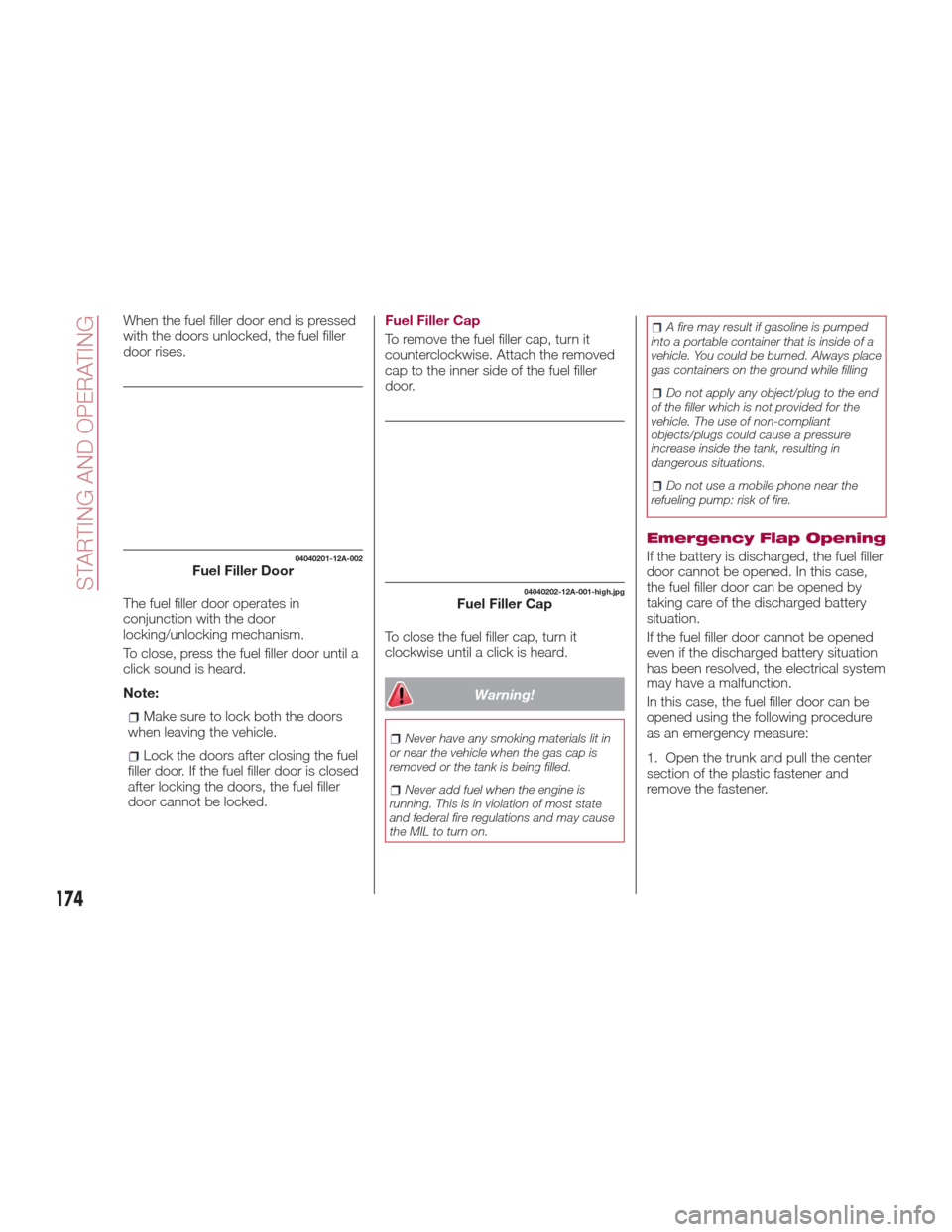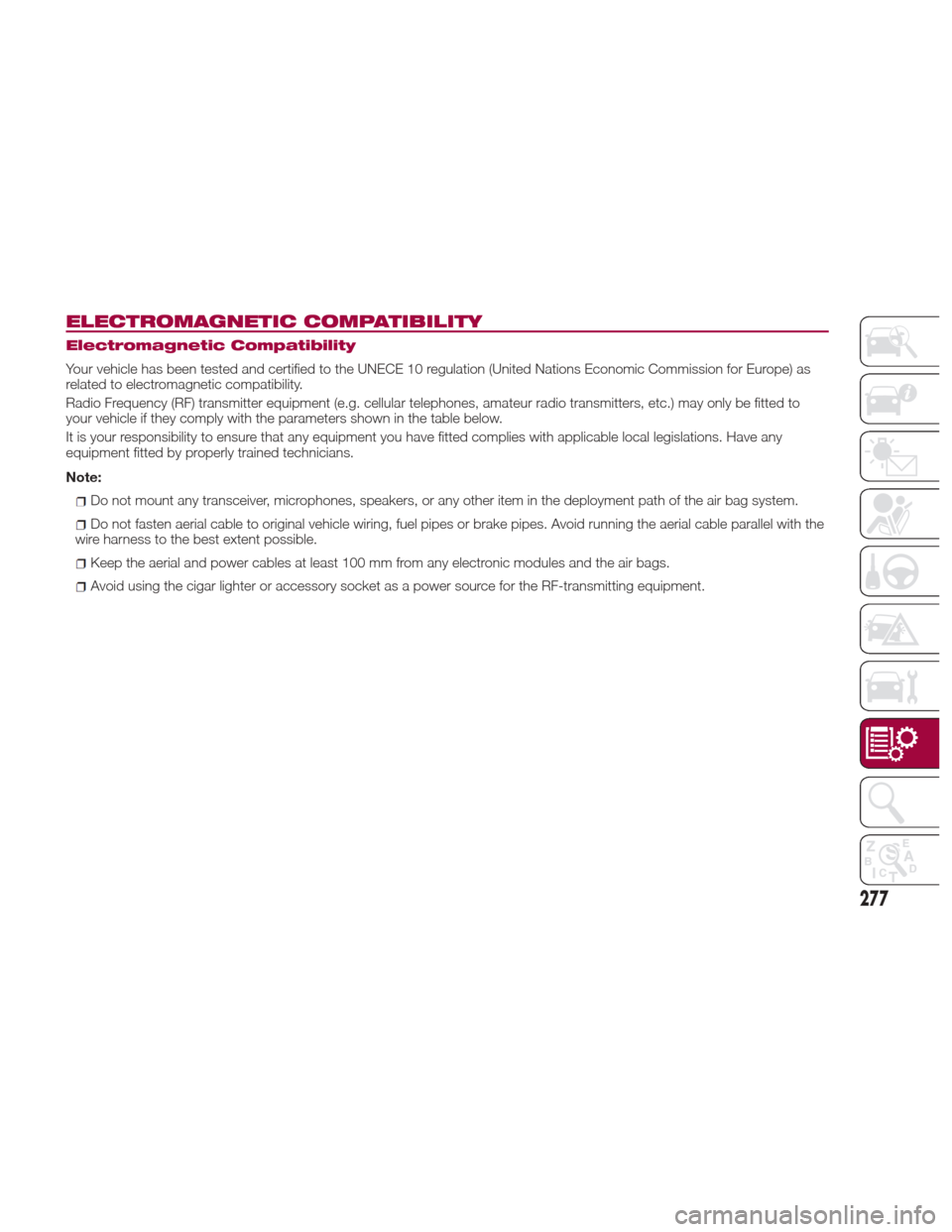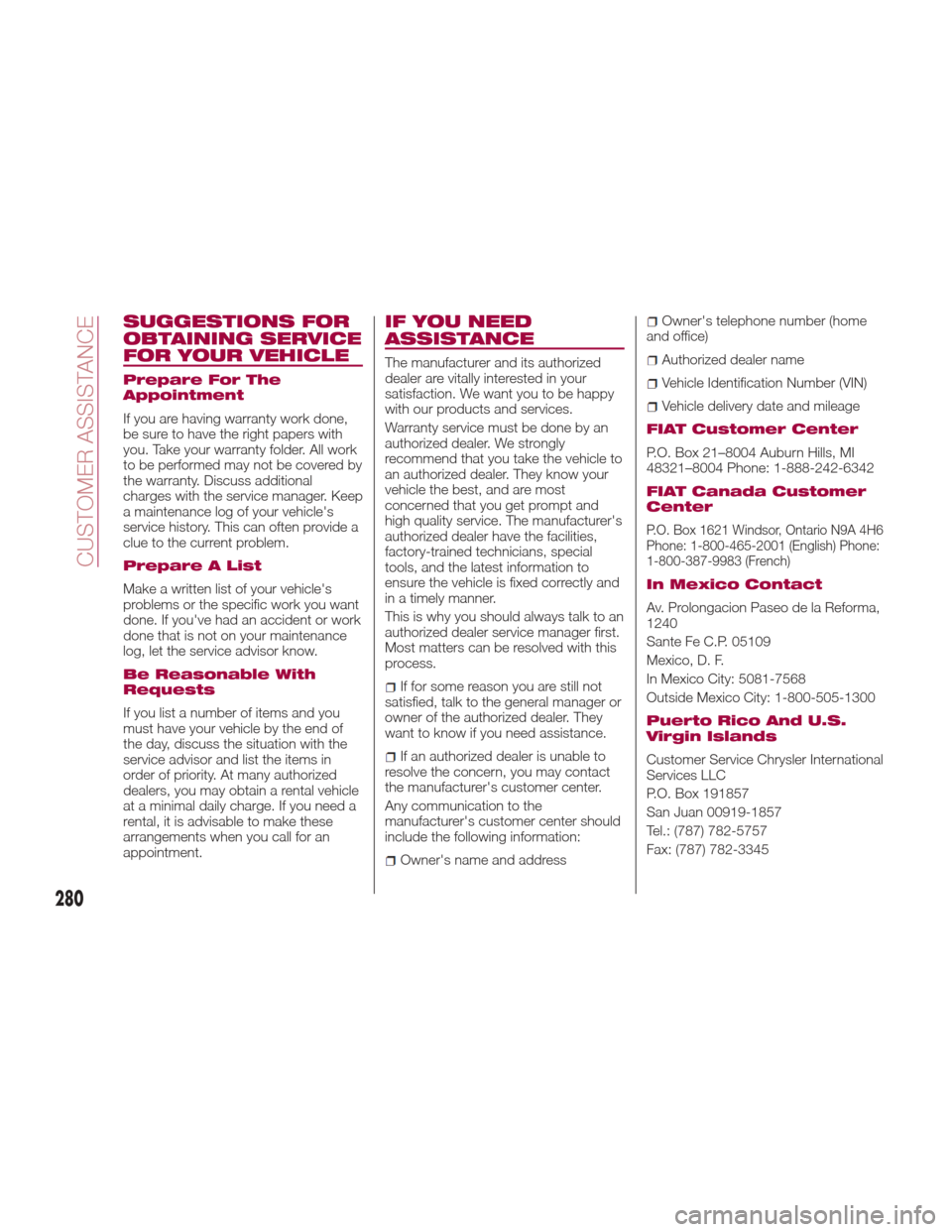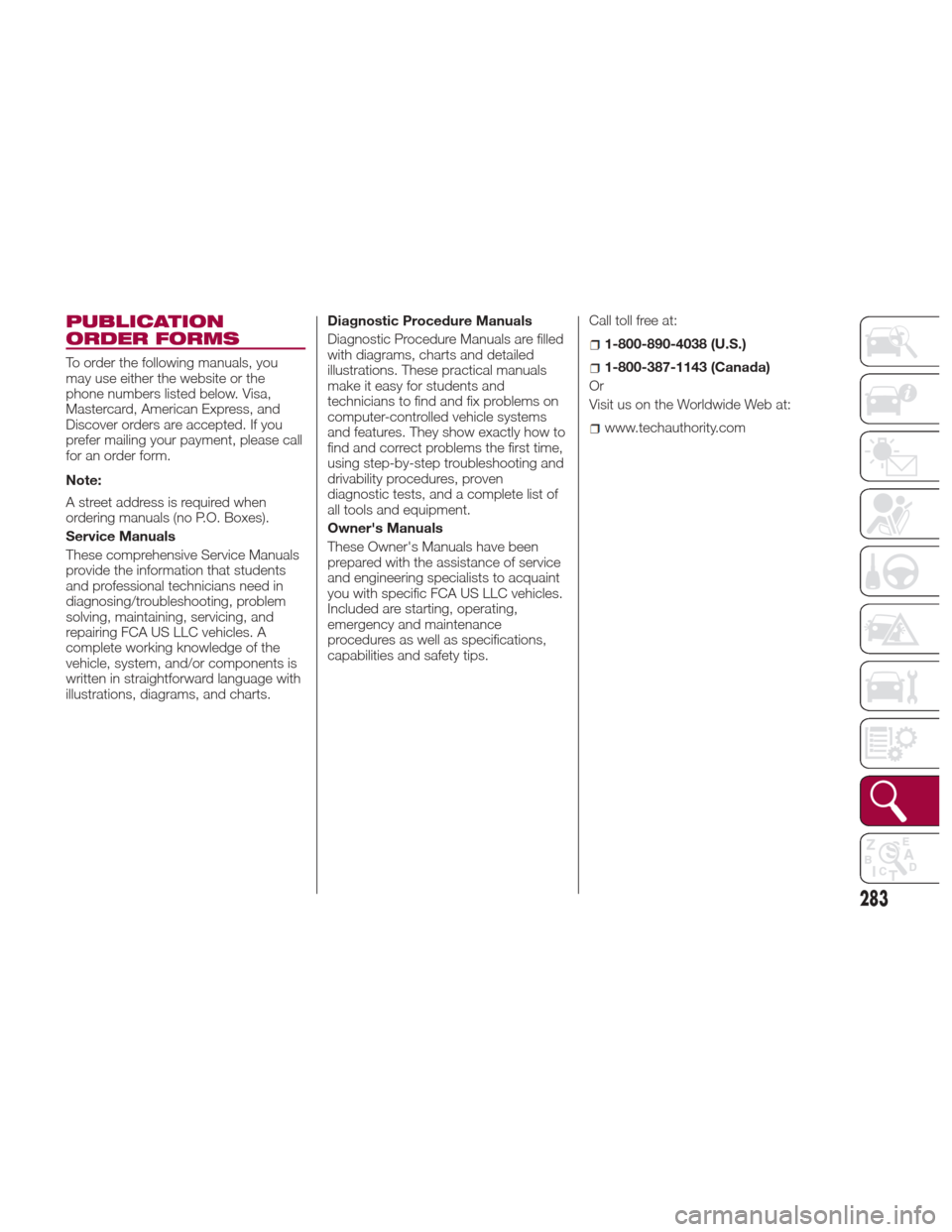2017 FIAT 124 SPIDER ABARTH phone
[x] Cancel search: phonePage 7 of 292

RADIO TRANSMITTERS AND MOBILE PHONES
Radio transmitter equipment (vehicle mobile phones, CB radios, amateur radio etc.) cannot be used inside the vehicle unless a
separate aerial is mounted externally.
Transmission and reception of these devices may be affected by the shielding effect of the vehicle body. As far as the use of
EC-approved mobile phones is concerned (GSM, GPRS, UMTS, LTE), follow the usage instructions provided by the mobile
phone Manufacturer.
The use of these devices inside the vehicle (without an external aerial) may cause the electrical systems to malfunction. This
could compromise the vehicle safety in addition to constituting a potential hazard for passengers' health.
If mobile phones/laptops/smartphones/tablets are inside the vehicle and/or close to the electronic key, a reduced performance
of the Advanced Keyless Entry System may occur.
CELL PHONE WARNING
IMPORTANT: Please comply with the legal regulations concerning the use of communication equipment in vehicles in your
country. Use of any electrical devices such as cell phones, computers, portable radios, vehicle navigation or other devices by
the driver while the vehicle is moving is dangerous. Dialing a number on a cell phone while driving also ties-up the driver's
hands. Use of these devices will cause the driver to be distracted and could lead to a serious accident. If a passenger is unable
to use the device, pull off the right-of-way to a safe area before use. If use of a cell phone is necessary despite this warning, use
a hands-free system to at least leave the hands free to drive the vehicle. Never use a cell phone or other electrical devices while
the vehicle is moving and, instead, concentrate on the full-time job of driving.
Page 22 of 292

5. Insert a new battery with the positive
pole facing up. Then, cover the battery
with the battery cap.
6. Close the cover and reinsert the
Emergency Key.
Note:Be careful not to allow the
rubber ring shown in call-out (6) to be scratched or damaged. If the rubber
ring comes out, reinstall it before
inserting a new battery.
Key Fob Cautions
Because the key fob uses low-intensity
radio waves, it may not function
correctly under the following conditions:
The key fob is carried with
communication devices such as cellular
phones.
The key fob contacts or is covered
by a metal object.
The key fob is near electronic
devices such as personal computers.
Non-FCA genuine electronic
equipment is installed in the vehicle.
There is equipment which discharges
radio waves near the vehicle.
The key fob may consume battery
power excessively if it receives
high-intensity radio waves. Do not place
the key fob near electronic devices
such as televisions or personal
computers.
To avoid damage to the key fob,
DO NOT:
Drop the key fob.
Get the key fob wet.
Disassemble the key fob.
Expose the key fob to high
temperatures on places such as the
instrument panel or engine
compartment, under direct sunlight.
Expose the key fob to any kind of
magnetic field.
Place heavy objects on the key fob.
Put the key fob in an ultrasonic
cleaner.
Put any magnetized objects close to
the key fob.
General Information
The following regulatory statement
applies to all Radio Frequency (RF)
devices equipped in this vehicle:
This device complies with Part 15 of the
FCC Rules and with Industry Canada
license-exempt RSS standard(s).
Operation is subject to the following
two conditions:
1. This device may not cause harmful
interference.
2. This device must accept any
interference received, including
interference that may cause undesired
operation.
Note:
Changes or modifications not expressly
approved by the party responsible for
compliance could void the user’s
authority to operate the equipment.
07031301-364-003Remove Back Cover For Battery Replacement
07031301-367-001Install New Battery
20
GETTING TO KNOW YOUR VEHICLE
Page 26 of 292

VEHICLE SECURITY
ALARM SYSTEM — IF
EQUIPPED
Modifications And
Add-On Equipment
FCA cannot guarantee the immobilizer
and the Security Alarm System
operation if the system has been
modified or if any add-on equipment
has been installed.
Note:To avoid damage to the vehicle,
do not modify the system or install any
add-on equipment to the immobilizer
and the Security Alarm System or the
vehicle.
Immobilizer System
The immobilizer system allows the
engine to start only with a key fob the
system recognizes.
If someone attempts to start the engine
with an unrecognized key fob, the
engine will not start, thereby helping to
prevent unlawful vehicle use.
If you have a problem with the
immobilizer system or the key fob,
contact an Authorized Dealership.
To avoid damage to the key fob, do not:
Drop the key fob.
Get the key fob wet.
Expose the key fob to any kind of
magnetic field.
Expose the key fob to high
temperatures on places such as the
instrument panel, hood, or under direct
sunlight.
Note:
Changes or modifications not
expressly approved by the party
responsible for compliance could void
the user's authority to operate the
equipment.
If the engine does not start with the
correct key fob, and thewarning
light keeps illuminating or flashing, the
system may have a malfunction.
Contact an Authorized Dealership.
The key fobs carry a unique
electronic code. For this reason, and to
assure your safety, obtaining a
replacement key fob can only be done
through your Authorized Dealership,
and will require some waiting time.
Always keep a spare key fob in
case one is lost. If a key fob is lost,
contact an Authorized Dealership as
soon as possible.
If you lose a key fob, an Authorized
Dealership will reset the electronic
codes of your remaining key fobs and
immobilizer system. Bring all the
remaining key fobs to an Authorized
Dealership to reset. Starting the vehicle
with a key fob that has not been reset
is not possible. Operation
The engine may not start and
warning light may illuminate or flash
if the key fob is placed in an area where
it is difficult for the system to detect the
signal, such as on the instrument panel.
Move the key fob to a location within
the signal range, cycle the ignition off,
and then restart the engine.
Note: Signals from a TV, radio station,
transceiver, or mobile telephone could
interfere with your immobilizer system. If
you are using the proper key fob and
the engine fails to start, check the
warning light.
Arming
The system is armed when the ignition
is cycled from the ON to OFF position.
The
warning light in the instrument
cluster flashes every two seconds until
the system is disarmed.
Disarming
The system is disarmed when the
ignition is placed in the ON position with
the correct programmed key fob. The
warning light illuminates for about
three seconds and then turns off. If the
engine does not start with the correct
key fob, and the
warning light
remains illuminated or flashing, try the
following:
Make sure the key fob is within the
operational range for signal
transmission.
24
GETTING TO KNOW YOUR VEHICLE
Page 176 of 292

When the fuel filler door end is pressed
with the doors unlocked, the fuel filler
door rises.
The fuel filler door operates in
conjunction with the door
locking/unlocking mechanism.
To close, press the fuel filler door until a
click sound is heard.
Note:
Make sure to lock both the doors
when leaving the vehicle.
Lock the doors after closing the fuel
filler door. If the fuel filler door is closed
after locking the doors, the fuel filler
door cannot be locked. Fuel Filler Cap
To remove the fuel filler cap, turn it
counterclockwise. Attach the removed
cap to the inner side of the fuel filler
door.
To close the fuel filler cap, turn it
clockwise until a click is heard.
Warning!
Never have any smoking materials lit in
or near the vehicle when the gas cap is
removed or the tank is being filled.
Never add fuel when the engine is
running. This is in violation of most state
and federal fire regulations and may cause
the MIL to turn on.
A fire may result if gasoline is pumped
into a portable container that is inside of a
vehicle. You could be burned. Always place
gas containers on the ground while filling
Do not apply any object/plug to the end
of the filler which is not provided for the
vehicle. The use of non-compliant
objects/plugs could cause a pressure
increase inside the tank, resulting in
dangerous situations.
Do not use a mobile phone near the
refueling pump: risk of fire.
Emergency Flap Opening
If the battery is discharged, the fuel filler
door cannot be opened. In this case,
the fuel filler door can be opened by
taking care of the discharged battery
situation.
If the fuel filler door cannot be opened
even if the discharged battery situation
has been resolved, the electrical system
may have a malfunction.
In this case, the fuel filler door can be
opened using the following procedure
as an emergency measure:
1. Open the trunk and pull the center
section of the plastic fastener and
remove the fastener.04040201-12A-002Fuel Filler Door
04040202-12A-001-high.jpgFuel Filler Cap
174
STARTING AND OPERATING
Page 279 of 292

ELECTROMAGNETIC COMPATIBILITY
Electromagnetic Compatibility
Your vehicle has been tested and certified to the UNECE 10 regulation (United Nations Economic Commission for Europe) as
related to electromagnetic compatibility.
Radio Frequency (RF) transmitter equipment (e.g. cellular telephones, amateur radio transmitters, etc.) may only be fitted to
your vehicle if they comply with the parameters shown in the table below.
It is your responsibility to ensure that any equipment you have fitted complies with applicable local legislations. Have any
equipment fitted by properly trained technicians.
Note:
Do not mount any transceiver, microphones, speakers, or any other item in the deployment path of the air bag system.
Do not fasten aerial cable to original vehicle wiring, fuel pipes or brake pipes. Avoid running the aerial cable parallel with the
wire harness to the best extent possible.
Keep the aerial and power cables at least 100 mm from any electronic modules and the air bags.
Avoid using the cigar lighter or accessory socket as a power source for the RF-transmitting equipment.
277
Page 282 of 292

SUGGESTIONS FOR
OBTAINING SERVICE
FOR YOUR VEHICLE
Prepare For The
Appointment
If you are having warranty work done,
be sure to have the right papers with
you. Take your warranty folder. All work
to be performed may not be covered by
the warranty. Discuss additional
charges with the service manager. Keep
a maintenance log of your vehicle's
service history. This can often provide a
clue to the current problem.
Prepare A List
Make a written list of your vehicle's
problems or the specific work you want
done. If you've had an accident or work
done that is not on your maintenance
log, let the service advisor know.
Be Reasonable With
Requests
If you list a number of items and you
must have your vehicle by the end of
the day, discuss the situation with the
service advisor and list the items in
order of priority. At many authorized
dealers, you may obtain a rental vehicle
at a minimal daily charge. If you need a
rental, it is advisable to make these
arrangements when you call for an
appointment.
IF YOU NEED
ASSISTANCE
The manufacturer and its authorized
dealer are vitally interested in your
satisfaction. We want you to be happy
with our products and services.
Warranty service must be done by an
authorized dealer. We strongly
recommend that you take the vehicle to
an authorized dealer. They know your
vehicle the best, and are most
concerned that you get prompt and
high quality service. The manufacturer's
authorized dealer have the facilities,
factory-trained technicians, special
tools, and the latest information to
ensure the vehicle is fixed correctly and
in a timely manner.
This is why you should always talk to an
authorized dealer service manager first.
Most matters can be resolved with this
process.
If for some reason you are still not
satisfied, talk to the general manager or
owner of the authorized dealer. They
want to know if you need assistance.
If an authorized dealer is unable to
resolve the concern, you may contact
the manufacturer's customer center.
Any communication to the
manufacturer's customer center should
include the following information:
Owner's name and address
Owner's telephone number (home
and office)
Authorized dealer name
Vehicle Identification Number (VIN)
Vehicle delivery date and mileage
FIAT Customer Center
P.O. Box 21–8004 Auburn Hills, MI
48321–8004 Phone: 1-888-242-6342
FIAT Canada Customer
Center
P.O. Box 1621 Windsor, Ontario N9A 4H6
Phone: 1-800-465-2001 (English) Phone:
1-800-387-9983 (French)
In Mexico Contact
Av. Prolongacion Paseo de la Reforma,
1240
Sante Fe C.P. 05109
Mexico, D. F.
In Mexico City: 5081-7568
Outside Mexico City: 1-800-505-1300
Puerto Rico And U.S.
Virgin Islands
Customer Service Chrysler International
Services LLC
P.O. Box 191857
San Juan 00919-1857
Tel.: (787) 782-5757
Fax: (787) 782-3345
280
CUSTOMER ASSISTANCE
Page 285 of 292

PUBLICATION
ORDER FORMS
To order the following manuals, you
may use either the website or the
phone numbers listed below. Visa,
Mastercard, American Express, and
Discover orders are accepted. If you
prefer mailing your payment, please call
for an order form.
Note:
A street address is required when
ordering manuals (no P.O. Boxes).
Service Manuals
These comprehensive Service Manuals
provide the information that students
and professional technicians need in
diagnosing/troubleshooting, problem
solving, maintaining, servicing, and
repairing FCA US LLC vehicles. A
complete working knowledge of the
vehicle, system, and/or components is
written in straightforward language with
illustrations, diagrams, and charts.Diagnostic Procedure Manuals
Diagnostic Procedure Manuals are filled
with diagrams, charts and detailed
illustrations. These practical manuals
make it easy for students and
technicians to find and fix problems on
computer-controlled vehicle systems
and features. They show exactly how to
find and correct problems the first time,
using step-by-step troubleshooting and
drivability procedures, proven
diagnostic tests, and a complete list of
all tools and equipment.
Owner's Manuals
These Owner's Manuals have been
prepared with the assistance of service
and engineering specialists to acquaint
you with specific FCA US LLC vehicles.
Included are starting, operating,
emergency and maintenance
procedures as well as specifications,
capabilities and safety tips.
Call toll free at:
1-800-890-4038 (U.S.)
1-800-387-1143 (Canada)
Or
Visit us on the Worldwide Web at:
www.techauthority.com
283
Page 288 of 292

Key Fob..................14
Emergency Key ............14
Programming Additional Key
Fobs ...................24
Key-In Reminder ..............21
Keyless Entry System...........15
Lane Change And Turn Signals ....41
Lane Change Assist ............41
Lap/Shoulder Belts ........123,125
Leaving Home Light System ......42
Life Of Tires ............... .245
Lights Daytime Running ...........40
Fog ...................41
Hazard Warning Flasher ......183
Passing .................40
Turn Signal ...............41
Loading Vehicle .............175
Tires ................. .240
Locks PowerDoor ........... .26,31
Maintaining the finish.........254
Maintenance Monitor ...........85
Maintenance procedures ........234
Manual Climate Control System ....48
Heating .................50
Manual transmission ..........151
Manual Transmission ..........151Manual, Service
.............283
Methanol ................. .172
Mirrors....................36 Automatic Dimming .........37
Electric Remote ............38
Exterior Folding ............38
Outside .................36
Rearview ................36
Occupant Restraints ..........122
Onboard Diagnostic System ......77
Operating Precautions ..........77
Outside Rearview Mirrors ........36
Overhead light (bulb replacement) . .193
Overheating, Engine ...........219
Overloading ............... .181
Owner's Manual (Operator Manual) ..........283
Paint damage touch-up ........256
Parking Brake ...............150
Passing Light ................40
Performance ...............276
Periodic checks (scheduled servicing) ............... .224
Personal Settings ............107
Personalization Features ........107
Placard, Tire And Loading Information ...............240
Plastic part maintenance ........258Power
Brakes ................ .149
Door Locks ............26,31
Mirrors .................38
Pregnant Women And Seat Belts . .124
Pretensioners Seat Belts ..............127
Protection from atmospheric agents (bodywork) ..........252
Radar Sensors.............160
Radial Ply Tires ..............244
Radio Frequency General Information ........20,23
Radio transmitter and mobile phones ...................5
Rear Camera ...............166
Rear lights (light bulbs) .........186
Rear Park Assist System ........161
Rearview Mirrors ..............36
Recommended Tire Inflation Pressure ............... .264
Recorder, Event Data ..........145
Recreational towing ...........176
Reformulated Gasoline .........172
Refueling procedure ...........173
Refueling the vehicle ..........171
Reminder, Seat Belt ...........127
Replacement Tires ............246
Replacing a bulb .............183
INDEX